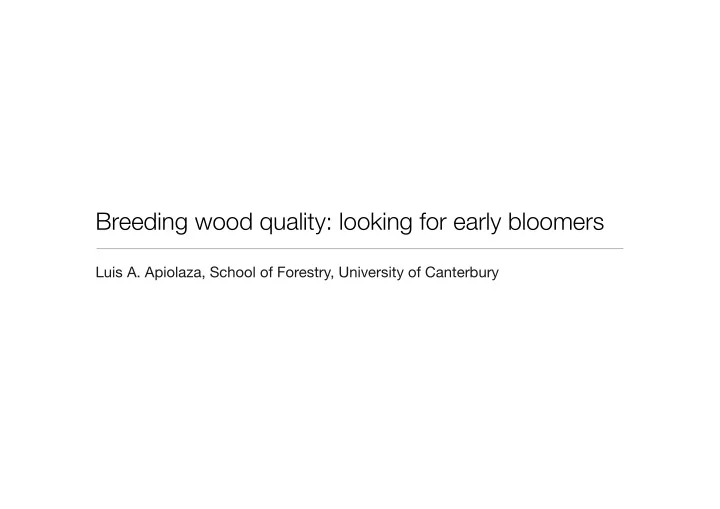

Breeding wood quality: looking for early bloomers Luis A. Apiolaza, School of Forestry, University of Canterbury
Plantation forestry is under strong competition Domestically from more profitable land uses; dairy, for example. Photo by pascalk, Flickr.
Plantation forestry is under strong competition Internationally from more profitable forest operations; eucalypts, for example. Photo by Corey Holmes, Flickr.
Tree breeding’s recipe (criteria) ≠ What we What we select for breed for (objective) age-age branch index NIRA correlations weighted stiffness weighted density volume form dbh form early selection rotation age
Implicit assumption: It works for growth...so it should for wood quality.
However, intrinsic wood quality has changed very little during the last 50 years.
We have explanations for everything, even when we claim we don't. I call explanations pacifiers*, to stop asking questions — Humberto Maturana *[UK, AU, NZ] dummy
Features to exploit about wood quality Price and quantity !'#" !"#$%&'()&('*+, -&'()&('*+, 012/- !'"" 012/4 !&#" +// +. !&"" !0:+30;& 012/3 +- !%#" !%"" 012. Technical thresholds Time trends !$#" 0125 +, !$"" !"#$%&'()* !#" 0 5 15 25 0 5 15 25 late bloomers !" DM016 DM017 DM018 DM020 DM021 % ' ( ) $" $% $' $( 20 20 15 *+,-.,/0123+,/240567890 10 15 5 DM011 DM012 DM013 DM014 DM015 10 20 15 5 10 MOE [GPa] 5 MOE [GPa] early bloomers DM006 DM007 DM008 DM009 DM010 20 15 20 10 5 Autoregressive 15 DM001 DM002 DM003 DM004 DM005 10 20 15 10 5 5 1.0 0 5 15 25 0 5 15 25 0 5 15 25 0 50 100 150 200 250 radius [mm from the pith] Ring [number from pith] 0.8 Correlation 0.6 0.4 0.2 0.0 0 5 10 15 20 25 30 Lag for age − age correlation
Value: not all changes are worth the same !'#" !"#$%&'()&('*+, -&'()&('*+, 012/- !'"" 012/4 !&#" +// +. !&"" !0:+30;& 012/3 +- !%#" !%"" 012. !$#" 0125 +, !$"" !"#$%&'()* !#" !" % ' ( ) $" $% $' $( *+,-.,/0123+,/240567890 1. Real value jump 2. Lots (!) of wood here Price in NZD for different timber grades. From Sorensson and Shelbourne 2005.
Assessment methods induce autocorrelation 1.0 r lag 0.8 (>0.9) autocorrelation ! Predicting rotation age Correlation 0.6 performance is hopeless 0.46 unless we have very high 0.4 0.21 0.2 0.95 0.09 0.90 0.0 0.85 0 5 10 15 20 25 30 Lag for age − age correlation
Time trends and technical thresholds 0 5 10 15 20 25 30 0 5 10 15 20 25 30 003 004 DM003 DM004 20 40 15 30 10 20 MFA [degrees] 5 MOE [GPa] 001 002 DM001 DM002 20 40 15 30 10 20 5 0 5 10 15 20 25 30 0 5 10 15 20 25 30 Ring [number from pith] Ring [number from pith] Threshold: 30° Threshold: 8 GPa
More than one way for changing the average We tend to screen in ...but screening out might be easier
Is ‘good enough’ good enough? or Would this work?
Variability: there is plenty of room for selection late bloomers 20 15 10 5 MOE [GPa] early bloomers 20 15 10 5 0 50 100 150 200 250 radius [mm from the pith]
What about genetic control? h 2 CV 0.45 14%
In summary, we are... ignoring ‘rotation age’ using small lags for age-age correlations going for very early selection (<4 years) how early do we meet the threshold? screening out the worst material proposing to use simple tools with moderate resolution
In summary, the best is enemy of the good breeding for the best possible quality breeding for early expression of acceptable quality
Every sentence I utter must be understood not as an affirmation but as a question — Niels Bohr Thanks J.C.F. Walker for relentless criticism RPBC and WQI for funding and data M. Avalos for design and patience
Recommend
More recommend